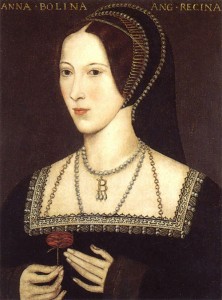 At dawn on the 19th May 1536, Anne celebrated the Mass for the last time, receiving the Sacrament from her almoner, John Skip. She then ate breakfast at 7am and waited to hear Sir William Kingston’s footsteps outside her door. At 8am, the Constable appeared, informing Anne that the hour of her death was near and that she should get herself ready, but Anne was already prepared.
At dawn on the 19th May 1536, Anne celebrated the Mass for the last time, receiving the Sacrament from her almoner, John Skip. She then ate breakfast at 7am and waited to hear Sir William Kingston’s footsteps outside her door. At 8am, the Constable appeared, informing Anne that the hour of her death was near and that she should get herself ready, but Anne was already prepared.
Dressed in a robe of grey or black damask trimmed with ermine, with a crimson kirtle underneath and an English style gable hood, Anne took her final walk out of the Queen’s Lodgings, past the Great Hall, through Cole Harbour Gate, along the western side of the White Tower to the black draped scaffold. Kingston helped her up the scaffold steps and Anne stepped forward to address the crowd which included many people she knew – Thomas Cromwell, Charles Brandon, Duke of Suffolk, Henry Fitzroy, Duke of Richmond (Henry VIII’s son), and Thomas Audley, the Lord Chancellor. The crowd fell silent as they gazed at their queen, who one witness described as being “never so beautiful”. Anne then gave her final speech:-
“Good Christian people, I have not come here to preach a sermon; I have come here to die. For according to the law and by the law I am judged to die, and therefore I will speak nothing against it. I am come hither to accuse no man, nor to speak of that whereof I am accused and condemned to die, but I pray God save the King and send him long to reign over you, for a gentler nor a more merciful prince was there never, and to me he was ever a good, a gentle, and sovereign lord. And if any person will meddle of my cause, I require them to judge the best. And thus I take my leave of the world and of you all, and I heartily desire you all to pray for me.”
She did not protest her innocence and preach to the crowd as her brother had, she simply did what was expected of her. Executions were carefully choreographed and there was a set format for execution speeches and Anne followed it to the letter. There was no way that she would risk her daughter’s safety by defying the King and proclaiming her innocence, Elizabeth’s safety and her future relationship with her father, the King, were paramount in Anne’s mind as she prepared to meet her Maker.
Her ladies then removed Anne’s mantle and Anne lifted off her gable hood and tucked her famous dark locks into a cap to keep it out of the way of the sword. Eric Ives writes of how her only show of fear was the way that she kept looking behind her to check that the executioner was not going to strike the fatal blow too soon. Anne paid the executioner, he asked Anne’s forgiveness and then Anne knelt upright in the straw, praying all the while “O Lord have mercy on me, to God I commend my soul. To Jesus Christ I commend my soul; Lord Jesu receive my soul.” As Anne prayed, the executioner called out to his assistant to pass him his sword and, as Anne moved her head to follow what the assistant was doing, the executioner came up unnoticed behind her and beheaded her with one stroke of his sword. Her ordeal was over – her head may have been in the straw but Anne’s soul was with her Father in Heaven.
As the shocked crowd dispersed, Anne’s ladies wrapped her head and body in white cloth and took them to the Chapel of St Peter ad Vincula, where she was placed inside a old elm chest which had once contained bow staves. Anne Boleyn, Queen of England and mother of Elizabeth I, was then buried as a traitor in an unmarked grave.
Today, I will be pausing a moment on the parade ground in front of the Waterloo Barracks, the place of Anne’s execution, and I will be paying my respects at Anne’s resting place in the Chapel. Many who visit the Tower this day will be unaware of Anne Boleyn’s story and the fact that today marks the anniversary of her death, but I hope our presence there will speak of the fact that she is not forgotten and that she is the Queen of so many hearts still today.